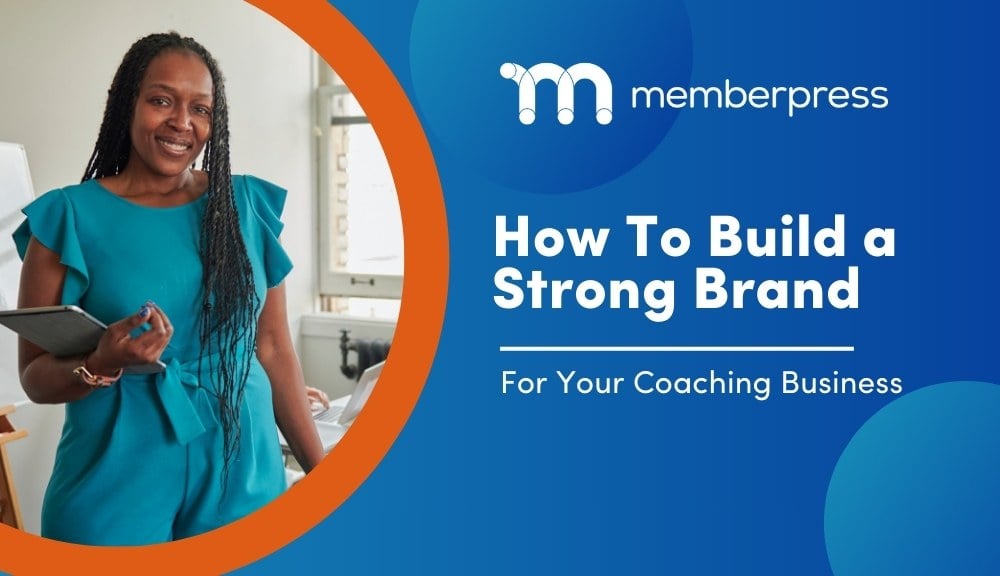In an increasingly competitive coaching market, building a strong brand is essential. Whether you’re a lifestyle, business, or fitness coach, read on to discover how to make your brand stand out.
Did you know that on average, people need to see your brand a minimum of 7 times before making a purchase? This fact is so well established in marketing circles that it has its own term: The Rule of 7.
It all boils down to one simple truth: the more visible your brand is, the more likely your audience is likely to trust you, connect with you, and eventually purchase from you.
But that visibility is only useful if you have a strong brand that’s easily recognizable and likely to repeatedly show up in your target audience’s algorithms.
It’s the difference between your audience finding you incidentally, and purposefully seeking you out the next time they need your services.
In this pitstop guide, we’ll walk through how you can create a compelling brand for your coaching business.
Why Focus on Building a Strong Brand?
Building a strong brand takes time and resources, but here’s why it’s well worth it for your coaching business:
- Standing Out: In the busy world of coaching, a strong brand is your ticket to standing out. It helps you highlight what makes you unique and why clients should choose you over the competition.
- Building Trust: When your branding is consistent and professional, it builds trust. Clients are more likely to feel confident in your services if your brand reflects credibility and reliability.
- Attracting and Keeping Clients: A well-defined brand resonates with your target audience. It not only attracts clients who vibe with your approach but also keeps them coming back by creating a meaningful connection.
- Strategic Growth: As your business grows, a strong brand provides a solid foundation. It ensures your messaging stays consistent, even as you expand your services or enter new markets.
- Google Likes It: Building a strong brand is important for your visibility in organic search results. You’re more likely to rank higher in SERPs with a strong brand presence.
Steps to Building Your Brand
1. Define Your Brand Identity – Get Personal!
Your brand identity communicates your purpose and central message that separates you from your competitors.
This is foundational to everything else about your brand, so it’s important to nail this one early on.
Take some time to clearly define your…
- Mission Statement: This is where you spell out your purpose and the value you bring to your clients. It should be clear and reflect your passion for coaching.
- Core Values: Identify the principles that guide your coaching practice. These values should resonate with your audience and permeate everything you do.
- Unique Selling Proposition (USP): Figure out what makes you different from other coaches. It could be your methods, expertise, or experience. Make sure your USP is clearly communicated in your branding.
MemberPress client, Dr Peter Attia, uses visuals on his website to convey his expertise and authority in his field.

His purpose and the value he provides his clients, members, and listeners to his hit podcast is also clearly communicated at the top of his site:
“Learn how to live longer, be healthier, and optimize your performance.”
2. Create a Visual Identity
A strong and consistent visual identity that reflects your brand identity is an immediate way to make a memorable impression and build trust with your audience.
- Logo: Design a logo that’s memorable, versatile, and well in different formats. If you don’t have the design chops, check out this automatic, try-before-you-buy logo generator by Fiverr.
- Color Scheme: Choose colors that match your brand’s personality. For example, blues often convey trust and professionalism, while greens suggest growth and wellness.
- Typography: Pick fonts that align with your brand’s tone. Consistent typography helps keep a polished and professional look that establishes trust.
- Design Style: Establish a cohesive design style for your website, social media, and marketing materials. Consistency helps with brand recognition.
- Imagery Style: When creating images and video content for social media, keep a consistent style of photos and graphics that reflects your brand. This could be bright and vibrant, minimalistic, or textured and artistic.
3. Develop Your Brand Voice and Messaging
Your brand voice is how you communicate with your audience:
- Tone: Decide on a tone that fits your coaching style. Some examples might be authoritative, friendly, or motivational. Whichever tone you choose, just make sure it aligns with your brand values.
- Messaging: Craft key messages that clearly convey your value and address your clients’ needs. Your messaging should be engaging and tailored to your audience.
- Content Strategy: Plan content that showcases your expertise and provides value. Think blog posts, podcasts, social media updates, and email newsletters.
An impactful way to communicate your brand identity and messaging is to share your personal story.
Ask yourself the following questions:
- What challenges have you overcome?
- Which commonly occurring frustrations and pain points can you personally identify with?
- What key lessons did you learn from your journey?
- What gaps in the market does your coaching service fill?
By sharing your experiences, you create an emotional connection that resonates more deeply with your audience. It also illustrates your authenticity and helps to reinforce your unique value proposition.
For a great example, take a look at MemberPress client and fitness coach, Pilates Guy. He includes his personal story in a video on his homepage.

4. Build Your Online Presence
You obviously need a website, social media channels, and at least a newsletter to establish your online presence. But it’s not enough to simply have these platforms; you need to use them intentionally.
Focus on truly connecting with your audience and understanding what resonates with them, and not just checking the TikTok box. Here are some things to consider to help you build an online brand that stands out and drives results…
- Engage on Social Media: Rather than just posting for the sake of it, create conversations. Share insights, ask questions, and respond to comments. This turns followers into a community and showcases your personality, making your brand more relatable.
- Craft a Compelling Website: Focus on storytelling and user experience. Use engaging visuals, client testimonials, and a clear call-to-action to guide visitors toward connecting with you.
- Leverage Email Marketing: Don’t just send updates – tell stories. Use your email marketing to share valuable content, lessons learned, or client success stories. Personalize your approach to create a deeper connection with your audience
. - Establish Yourself as a Thought Leader: Share your expertise through blogs, videos, or podcasts that address pressing issues in your niche. By providing valuable insights, you position yourself as a go-to resource, building credibility and attracting clients who seek your knowledge.
- Join Relevant Online Communities: Be where your potential clients are. Engage in forums, Facebook groups, or LinkedIn discussions related to your niche. Share your expertise, answer questions, and build relationships that can lead to referrals.
5. Foster Strong Client Relationships
A big part of your brand is how your clients experience your coaching services.
When clients feel valued and supported, they can become ambassadors for your brand, helping you attract new clients through positive reviews and word-of-mouth.
Here are key strategies to help you connect deeply with your clients and foster loyalty:
- Create a Community: Encourage a sense of belonging among your clients. Consider hosting group coaching sessions, workshops, or online forums where they can connect, share experiences, and support one another.
- Communicate Openly and Frequently: Regular check-ins, show clients you care about their progress.
CoachKit™, our solution for managing training programs on your site, lets you automatically send check-in emails to students at key milestones or if they’re falling behind on tracking their habits.
And with CoachKit’s™ direct messaging feature, there’s an easier way for clients to connect with their coaches.
These features help keep the lines of communication wide open so clients know they can reach out to their coach if they need assistance.
- Personalize Your Approach: Every client is unique. Tailor your coaching methods to meet individual needs and preferences.
Whether it’s adjusting your video call sessions or celebrating their milestones, a personalized touch makes clients feel valued and understood.
CoachKit™ integrates with Calendly to allow coaches to set their available hours so that clients can schedule appointments at a time that suits them.
Plus with MemberPress shortcodes, you can easily personalize your pages, posts, course material, and communications with your client’s first name. - Solicit Feedback: Actively seek feedback on your coaching methods and client experience. This shows you’re invested in their growth and willing to adapt. Use their insights to refine your approach and enhance the overall experience.
Overall, make sure your online coaching setup puts your clients’ needs first. Work on creating genuine and memorable connections that your clients will want to shout about.
You can learn more about CoachKit™ in our blog post dedicated to our online coaching platform.
Conclusion
Building a strong brand for your coaching business will help you stand out from the competition and cultivate trust and loyalty among your clients.
Remember the essential steps:
- Take time to develop your brand identity,
- Create a compelling visual presence,
- Develop a unique voice,
- Build an engaging online presence,
- Nurture client relationships.
As you implement these strategies, remember that authenticity and consistency are key. When clients feel valued, they are more likely to advocate for your brand and refer others to your services.
Take the time to refine your brand, connect with your audience, and watch as your coaching business thrives with a strong, recognized, and trusted brand.
For more insights and tools to enhance your coaching practice, explore how CoachKit™ can help you streamline your processes and nurture meaningful client relationships.
You might also be interested in our blog post How To Start a Life Coaching Business.
Which of the strategies above have you found most useful? Let us know in the comments section below!
If you found this article helpful, follow us on Facebook, Twitter, Instagram, and LinkedIn!














Thank you for these advices, helped a lot!
Great tips! I found the Rule of 7 really interesting and will definitely be taking that into consideration when assessing the visibility and consistency of my outreach to potential customers.
Building an unique brand allows coaches nowadays to differentiate themselves from others in an authentic way. Great tips on this article and I will add the importance of acknowledging their “why” and simplify the “what” of their coaching business as well as “who” they want to attract for their brand.
Sofia Reis